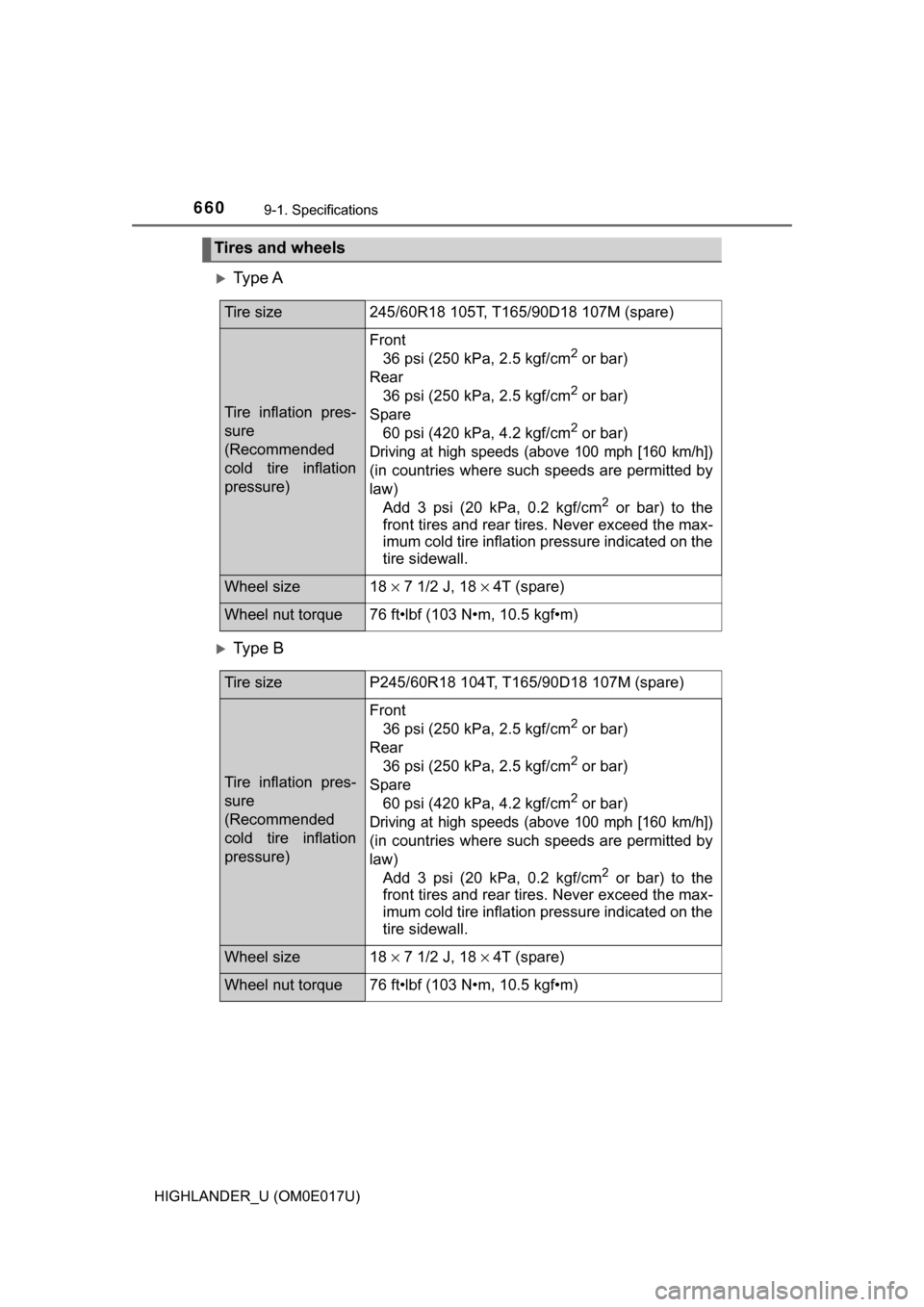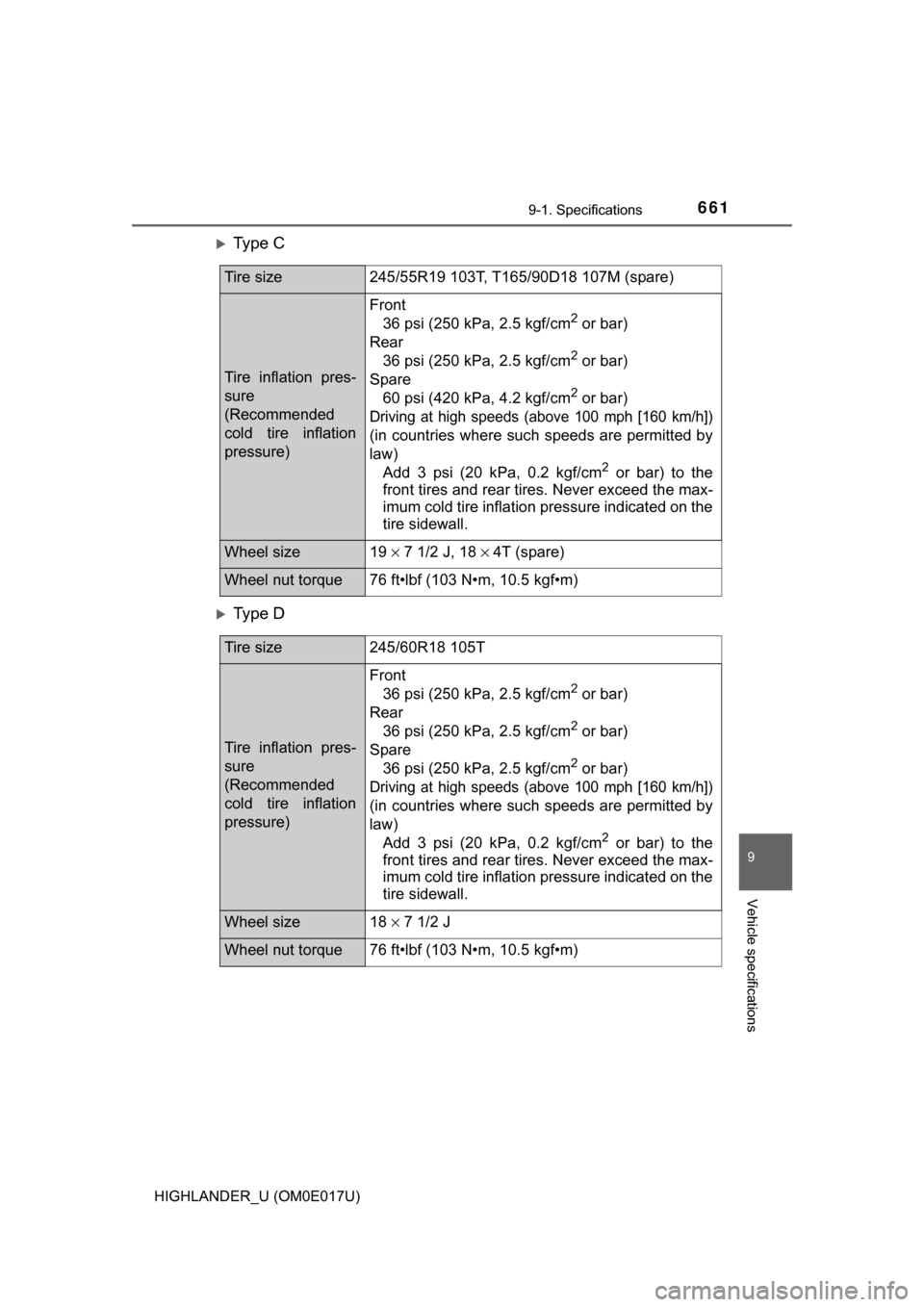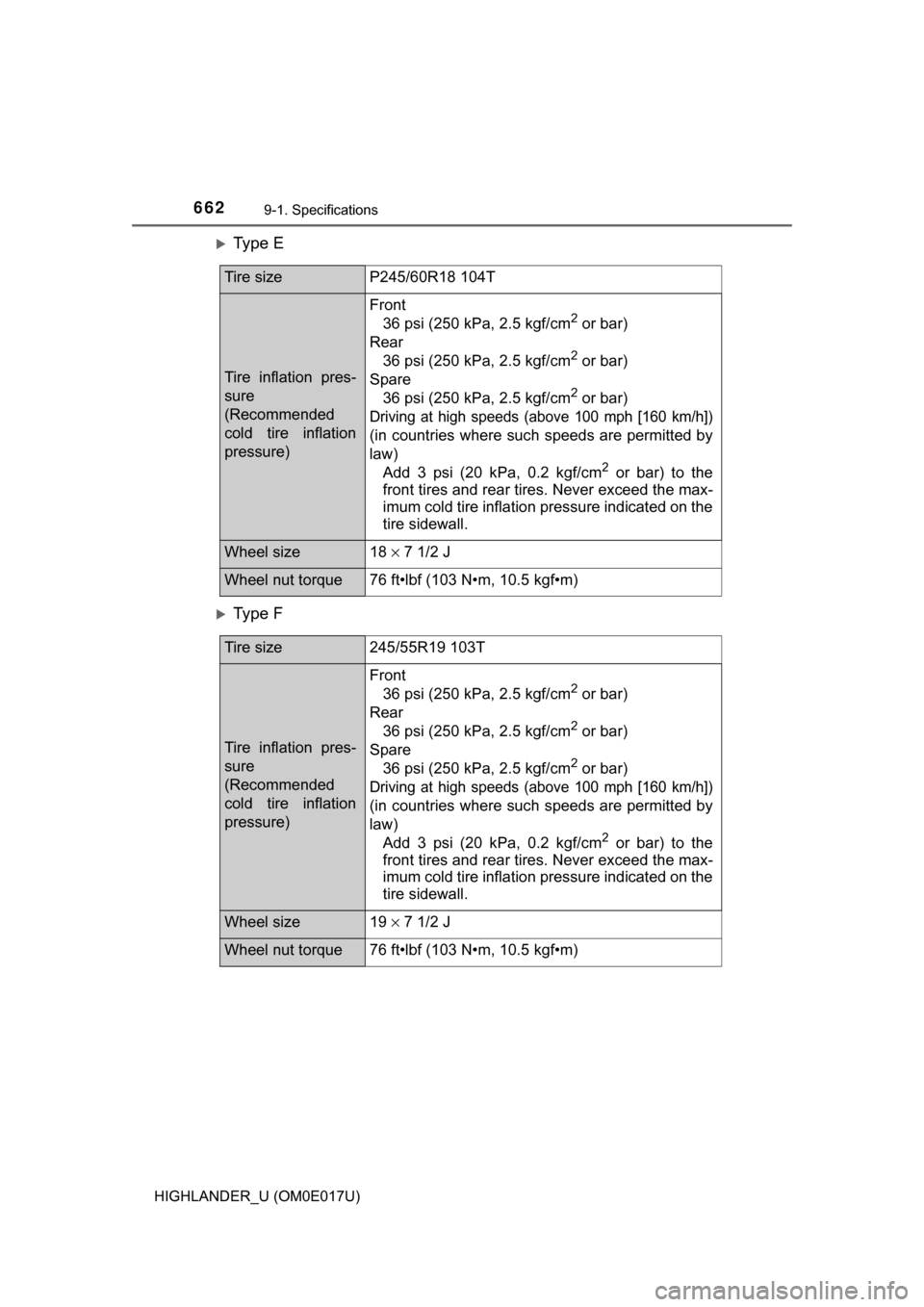Page 648 of 732
6488-2. Steps to take in an emergency
HIGHLANDER_U (OM0E017U)
WARNING
■When attempting to free a stuck vehicle
If you choose to push the vehicle back and forth to free it, make sure the
surrounding area is clear to avoid striking other vehicles, objects or people.
The vehicle may also lunge forward or lunge back suddenly as it becomes
free. Use extreme caution.
■ When shifting the shift lever
Be careful not to shift the shift lever with the accelerator pedal depressed.
This may lead to unexpected rapid acceleration of the vehicle that may
cause an accident resulting in death or serious injury.
NOTICE
■To avoid damaging the transm ission and other components
● Avoid spinning the front wheels and depressing the accelerator pedal
more than necessary.
● If the vehicle remains stuck even after these procedures are performed,
the vehicle may require towing to be freed.
Page 650 of 732
650
HIGHLANDER_U (OM0E017U)
9-1. Specifications
*1: Unladen vehicles
*2: The model code is indicated on the Certification Label. (→P. 651)
*3: With a seating capacity of 7 occupants
*4: With a seating capacity of 8 occupants
Maintenance data (fuel, oil level, etc.)
Dimensions
Overall length 192.5 in. (4890 mm)
Overall width 75.8 in. (1925 mm)
Overall height*1
Without roof antenna
68.1 in. (1730 mm)
With roof antenna
70.1 in. (1780 mm)
Wheelbase 109.8 in. (2790 mm)
Front tread64.4 in. (1635 mm)
Rear tread 64.2 in. (1630 mm)
Weights
Model code *2
Vehicle capacity
weight
(Occupant + lug-
gage)Trailer Weight Rating
(Trailer weight + cargo
weight)
ASU50L-ARTNKA 1460 lb. (660 kg) 1500 lb. (680 kg)
GSU50L-ARZNHA 1370 lb. (620 kg)
5000 lb. (2200 kg)
GSU50L-ARZMHA
1300 lb. (590 kg)
*3
1370 lb. (620 kg)*4
GSU50L-ARZGHA
1300 lb. (590 kg)*3
1370 lb. (620 kg)*4
GSU55L-ARZNHA 1370 lb. (620 kg)
GSU55L-ARZMHA1300 lb. (590 kg)
*3
1340 lb. (610 kg)*4
GSU55L-ARZGHA 1280 lb. (580 kg)
Page 660 of 732

6609-1. Specifications
HIGHLANDER_U (OM0E017U)
Ty p e A
Ty p e B
Tires and wheels
Tire size245/60R18 105T, T165/90D18 107M (spare)
Tire inflation pres-
sure
(Recommended
cold tire inflation
pressure)
Front36 psi (250 kPa, 2.5 kgf/cm2 or bar)
Rear 36 psi (250 kPa, 2.5 kgf/cm
2 or bar)
Spare 60 psi (420 kPa, 4.2 kgf/cm
2 or bar)
Driving at high speeds (above 100 mph [160 km/h])
(in countries where such speeds are permitted by
law)Add 3 psi (20 kPa, 0.2 kgf/cm
2 or bar) to the
front tires and rear tires. Never exceed the max-
imum cold tire inflation pressure indicated on the
tire sidewall.
Wheel size18 × 7 1/2 J, 18 × 4T (spare)
Wheel nut torque76 ft•lbf (103 N•m, 10.5 kgf•m)
Tire sizeP245/60R18 104T, T165/90D18 107M (spare)
Tire inflation pres-
sure
(Recommended
cold tire inflation
pressure)
Front
36 psi (250 kPa, 2.5 kgf/cm2 or bar)
Rear 36 psi (250 kPa, 2.5 kgf/cm
2 or bar)
Spare 60 psi (420 kPa, 4.2 kgf/cm
2 or bar)
Driving at high speeds (above 100 mph [160 km/h])
(in countries where such speeds are permitted by
law)Add 3 psi (20 kPa, 0.2 kgf/cm
2 or bar) to the
front tires and rear tires. Never exceed the max-
imum cold tire inflation pressure indicated on the
tire sidewall.
Wheel size18 × 7 1/2 J, 18 × 4T (spare)
Wheel nut torque76 ft•lbf (103 N•m, 10.5 kgf•m)
Page 661 of 732

6619-1. Specifications
9
Vehicle specifications
HIGHLANDER_U (OM0E017U)
Ty p e C
Ty p e D
Tire size245/55R19 103T, T165/90D18 107M (spare)
Tire inflation pres-
sure
(Recommended
cold tire inflation
pressure)
Front36 psi (250 kPa, 2.5 kgf/cm2 or bar)
Rear 36 psi (250 kPa, 2.5 kgf/cm
2 or bar)
Spare 60 psi (420 kPa, 4.2 kgf/cm
2 or bar)
Driving at high speeds (above 100 mph [160 km/h])
(in countries where such speeds are permitted by
law)Add 3 psi (20 kPa, 0.2 kgf/cm
2 or bar) to the
front tires and rear tires. Never exceed the max-
imum cold tire inflation pressure indicated on the
tire sidewall.
Wheel size19 × 7 1/2 J, 18 × 4T (spare)
Wheel nut torque76 ft•lbf (103 N•m, 10.5 kgf•m)
Tire size245/60R18 105T
Tire inflation pres-
sure
(Recommended
cold tire inflation
pressure)
Front
36 psi (250 kPa, 2.5 kgf/cm2 or bar)
Rear 36 psi (250 kPa, 2.5 kgf/cm
2 or bar)
Spare 36 psi (250 kPa, 2.5 kgf/cm
2 or bar)
Driving at high speeds (above 100 mph [160 km/h])
(in countries where such speeds are permitted by
law)Add 3 psi (20 kPa, 0.2 kgf/cm
2 or bar) to the
front tires and rear tires. Never exceed the max-
imum cold tire inflation pressure indicated on the
tire sidewall.
Wheel size18 × 7 1/2 J
Wheel nut torque76 ft•lbf (103 N•m, 10.5 kgf•m)
Page 662 of 732

6629-1. Specifications
HIGHLANDER_U (OM0E017U)
Ty p e E
Ty p e F
Tire sizeP245/60R18 104T
Tire inflation pres-
sure
(Recommended
cold tire inflation
pressure)
Front36 psi (250 kPa, 2.5 kgf/cm2 or bar)
Rear 36 psi (250 kPa, 2.5 kgf/cm
2 or bar)
Spare 36 psi (250 kPa, 2.5 kgf/cm
2 or bar)
Driving at high speeds (above 100 mph [160 km/h])
(in countries where such speeds are permitted by
law)Add 3 psi (20 kPa, 0.2 kgf/cm
2 or bar) to the
front tires and rear tires. Never exceed the max-
imum cold tire inflation pressure indicated on the
tire sidewall.
Wheel size18 × 7 1/2 J
Wheel nut torque76 ft•lbf (103 N•m, 10.5 kgf•m)
Tire size245/55R19 103T
Tire inflation pres-
sure
(Recommended
cold tire inflation
pressure)
Front
36 psi (250 kPa, 2.5 kgf/cm2 or bar)
Rear 36 psi (250 kPa, 2.5 kgf/cm
2 or bar)
Spare 36 psi (250 kPa, 2.5 kgf/cm
2 or bar)
Driving at high speeds (above 100 mph [160 km/h])
(in countries where such speeds are permitted by
law)Add 3 psi (20 kPa, 0.2 kgf/cm
2 or bar) to the
front tires and rear tires. Never exceed the max-
imum cold tire inflation pressure indicated on the
tire sidewall.
Wheel size19 × 7 1/2 J
Wheel nut torque76 ft•lbf (103 N•m, 10.5 kgf•m)
Page 670 of 732
6709-1. Specifications
HIGHLANDER_U (OM0E017U)■
Typical tire size information
The illustration in
dicates typical
tire size.
Tire use (P = Passenger car,
T = Temporary use)
Section width (millimeters)
Aspect ratio
(tire height to section width)
Tire construction code
(R = Radial, D = Diagonal)
Wheel diameter (inches)
Load index
(2 digits or 3 digits)
Speed symbol
(alphabet with one letter)
■Tire dimensions
Section width
Tire height
Wheel diameter
Tire size
1
2
3
4
5
6
7
1
2
3
Page 673 of 732

6739-1. Specifications
9
Vehicle specifications
HIGHLANDER_U (OM0E017U)■
Temperature A, B, C
The temperature grades are A (the
highest), B, and C, representing
the tire’s resistance to the generation of heat and its ability to dissi-
pate heat when tested under co ntrolled conditions on a specified
indoor laboratory test wheel.
Sustained high temperature can c ause the material of the tire to
degenerate and reduce tire life, and excessive temperature can lead
to sudden tire failure.
Grade C corresponds to a level of performance which all passenger
car tires must meet under the Federal Motor Vehicle Safety Stan-
dard No. 109.
Grades B and A represent higher levels of performance on the labo-
ratory test wheel than the minimum required by law.
Warning: The temperature grades of a tire assume that it is properly
inflated and not overloaded.
Excessive speed, underinflation, or excessive loading, either sepa-
rately or in combination, can cause heat buildup and possible tire
failure.
Page 675 of 732

6759-1. Specifications
9
Vehicle specifications
HIGHLANDER_U (OM0E017U)
Production options
weight
The combined weight of installed regular pro-
duction options weighing over 5 lb. (2.3 kg) in
excess of the standard items which they
replace, not previously considered in curb
weight or accessory weight, including heavy
duty brakes, ride levelers, roof rack, heavy
duty battery, and special trim
Rim
A metal support for a tire or a tire and tube
assembly upon which the tire beads are
seated
Rim diameter
(Wheel diameter)Nominal diameter of the bead seat
Rim size designationRim diameter and width
Rim type designationThe industry manufacturer’s designation for a
rim by style or code
Rim widthNominal distance between rim flanges
Vehicle capacity
weight (Total load
capacity)The rated cargo and luggage load plus 150 lb.
(68 kg) times the vehicle’s designated seating
capacity
Vehicle maximum load
on the tire
The load on an individual tire that is deter-
mined by distributing to each axle its share of
the maximum loaded vehicle weight, and
dividing by two
Vehicle normal load on
the tire
The load on an individual tire that is deter-
mined by distributing to each axle its share of
curb weight, accessory weight, and normal
occupant weight (distributed in accordance
with Table 1
* below), and dividing by two
Weather sideThe surface area of the rim not covered by the
inflated tire
Bead
The part of the tire that is made of steel wires,
wrapped or reinforced by ply cords and that is
shaped to fit the rim
Bead separationA breakdown of the bond between compo-
nents in the bead
Tire related termMeaning